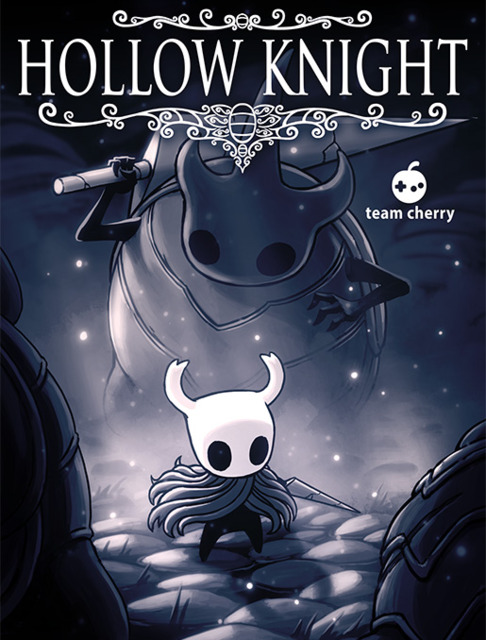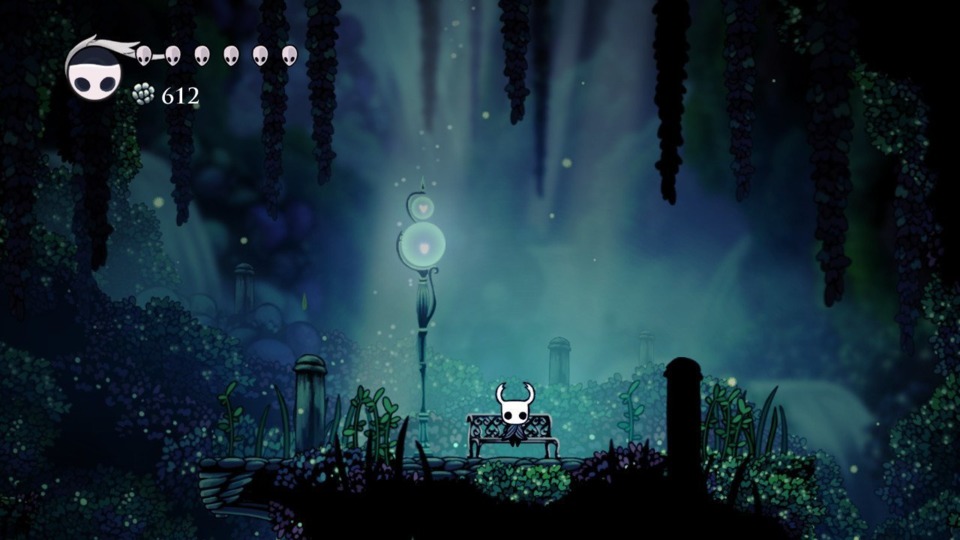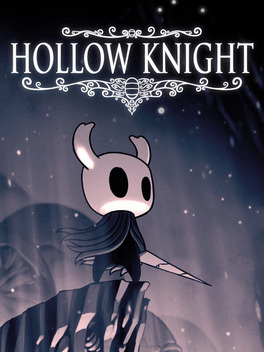
It's not uncommon for games, especially Indie games, to embrace the new and old alike. That dichotomy of creating something fresh and relevant from a blueprint that is many decades extant. I suppose it's not unlike a classic car chassis placed over a modern engine and state-of-the-art computer systems; a certain "cheating" of nostalgia for the sake of creating something contemporaneous out of something otherwise antiquated but still beloved and containing of merit. That's where we get games like Team Cherry's Hollow Knight: a relatively straightforward 2D platformer with a spacewhipper exploration angle that enjoys a layer of complexity due to a few notions borrowed from FromSoftware's Souls franchise.
On the surface, Hollow Knight is comparatively rudimentary, at least compared to other "Soulslikes". The game's health system simply boils down to an amount of hits the player can take that usually numbers in the single digits. There's no equipment, though you can sharpen your main - and only - weapon at the cost of some rare resources. There's no levels, no experience, nothing more elaborate than acquiring new health and "soul" upgrades (the latter essentially a source of mana that regenerates after attacking enemies) and the traversal power-ups common to the genre. It's no more an RPG than The Legend of Zelda, unlike what I'd arguably call its closest contemporary Salt & Sanctuary. The game's progression is equally basic: you run around fighting bosses, finding such quotidian power-ups as a wall-jump or a dash, locating nodes of wealth and other collectibles off the beaten path that might require backtracking to an older area with a new upgrade, and so on. In this regard, it's a very traditional 2D spacewhipper of the like you've seen several times before.
The Souls edge (not that one) does provide two big pros in its corner, however. The first and most striking of which is the game's aesthetic: a gloomy, Gothic setting of an ancient kingdom past its prime filled with venomous outlands and the mindless ambulatory corpses of the civilized folk who once lived there. Whether this makes it more or less unsettling I've yet to decide, but the people of this game - the NPCs, the former living, the protagonist - are all bugs and insects of various species, with sprites animated with a hand-drawn look that recalls, in my mind, the almost Bluthian fluidity of the Ori games as well as a certain nocturnal beauty to its immense cavernous backdrops that resembles the quiet, almost contemplative subterranean tunnels of Knytt Underground. Even if there's something cute about the diminutive hero or attractive about settings like the City of Tears and its perpetual rainfall, the game makes ample scary use of its arachnid and insectoid citizens: maggots, flying swarms, moths, centipedes, mantids, cockroaches, spiders, and really anything that might cause someone to leap five feet into the air and look for the closest newspaper to roll up (won't the insect-averse be sad once the printed press is finally extinct? And fans of Marmaduke too, I guess). Any sort of disquieting depiction of our creepy-crawlie friends are invariably in Hollow Knight in some form, and it dovetails nicely with the usual Souls-esque themes of corruption and decay.

The second benefit is how it influences the game's difficulty and progression, of the type that is not exactly welcoming but neither is it insurmountable nor inexplicable. The Souls games have always offered alternatives to having to fight That One Boss: not to say that you can usually avoid it forever, but that you can choose instead to level up a bit, try a different weapon loadout or approach, or go explore somewhere else for a while for the resources and experience you could use to make that one fight slightly easier on yourself. Not too reveal too much of Hollow Knight's mid-game where I presently sit, but I've been given several targets to tackle in any order I wish; beyond icons on the map, however, I've no idea how to reach them or what I might even need to reach them. Instead, I go wherever is currently available, which right now include three locations deep below where I've already explored and threaten to be even darker and more dangerous than anywhere I've visited previously. There's no doubt I'll either find who I'm looking for, or at least acquire a new ability that will permit me to meet them, but the lack of any concrete direction is something the Souls series has always relied on for the sake of instilling a sense of wanderlust in the player - the idea that you should explore a place not because there's a plot-vital imperative to do so, but because it exists.
While Hollow Knight does minimize a lot of the moving parts that would engender a great deal of customizable versatility - there's only one weapon, as previously stated, and nothing much in the way of "builds" or "loadouts" - there is a charm system that operates much like the skill system of a Tales game or the Mario & Luigi series. That is, you have a limited amount of points to assign to a large pool of useful abilities and have to determine the best ones for the current situation. For instance, I have a completely different set of charms for exploring than I do for fighting bosses: for the former, I have a charm that shows where I am on the map (sort of odd that it requires its own skill, but more on that in just a moment), one that magnetically draws dropped currency to me, and a charm - that breaks upon death, but that's less of a concern if I'm cautiously exploring - that increases the amount of money I earn. For bosses, I instead go for charms that increase damage or health or allow me to heal more often.
Even boiled down its absolute basics sans charms and the like, there's something distinctly clever about the game's use of soul and healing system: you start with an ability to use soul - a resource acquired through damaging enemies - to heal yourself, though it takes about a second or two to activate. Like Estus, this forces you to seize upon gaps in the enemy's attack patterns to sneak in a quick heal. You'll realize that when a boss enters a stun state after a certain amount of damage, it's not only opened itself up to a few easy hits but it's also the developers giving you, the player, a brief window to recuperate. The larger bosses hit harder and are difficult to avoid, but are slow enough that you can usually risk healing more often; while faster and smaller foes might have patterns that you can work around, but very little chance to find breathing room. There are times when I've lost a boss fight because I misjudged when and even if I could heal, taking hits upon hits while trying to do so, and then tackled the same boss fight again and defeated it because I focused on not getting hit and hoping to outlast them. Since Hollow Knight lacks boss health bars, that latter tactic can get pretty tense.
All that said, there's a certain point where Hollow Knight's philosophy of never holding the player's hand and making things challenging for them at all times can go too far. For me that point is usually when the player's time isn't being appreciated, and certain convenient quality-of-life features are either heavily taxed or entirely absent. To follow up on that example before, where the map system is compromised unless you dedicate a valuable charm slot to being able to see the player icon on the map; the game's map system requires a lot of investment before it reaches the same level of accessibility as the built-in map features of most any other spacewhipper. You need to find the map guy in each new area and buy a map from him to have the framework to build on (if you check the mini-map before then, you just get a "no map for this area" note, and on the larger map it looks like you're running around in the void), and the map won't fill in new areas you've visited until you've reached one of the game's sparse checkpoints - a bench, some of which also need to be activated for use by either spending money or fighting a mini-boss - and the protagonist has an opportunity to sketch them all in on their own copy of the map. The game has only recently patched in map markers to be placed on spots where you're stymied by a missing traversal power-up or any other site of import, and you have finite amount of them AND you need to buy them from the map shop back at the game's hub town. Likewise, you have to buy icons for vendors, benches, and most other places of interest, as well as the quill needed to draw in previously explored locations. (None of this map gear is too expensive, necessarily, but it will collectively require most of the early caches you find.) There is at least fast travel, though the waypoints aren't always located in convenient locations, and so the amount of backtracking is considerably greater here than elsewhere. Agnostically speaking, there's merits to this more hardscrabble approach to the comfortable niceties we take for granted in most games of this type - there's a reason all these hard graft survival simulators are taking off on PC - but I don't generally consider taking away quality-of-life modernizations to be an acceptable substitute for increased challenge. Just one small bee in my bonnet when it comes to how this game was designed.
Oh the whole, however, I'm loving this game as much as I anticipated I would. The boss fights are challenging without causing me undue frustration, the spacewhipper elements are all on point and so far don't break the cardinal rules (no collectibles in places you can't revisit, for instance), I'm enjoying piecing together the game's mythology and the more obtuse aspects of its story (killing dreams?!), it looks great, plays fluidly, there's a bestiary and the guy who wrote it is a complete psychopath, the charm system give me so many varied choices for preferred playstyles and - like in The Binding of Isaac - can create combinations with curious synergies, and it's grabbed me in such a way that even now - as I'm writing this - I'm tracking in my mind where I should be going next and what I need to progress in some other areas where I've met an impasse. It's the most excited I've been for a spacewhipper since, well, Salt & Sanctuary. Given how frequently games with the Souls format are themed around a perpetual system constantly on the wane, there's evidently a lot of life to it yet.
Rating: 5 out of 5. (So far.)
| < Back to 88: Yoku's Island Express | > Forward to 90: Shadowrun: Hong Kong |

Log in to comment